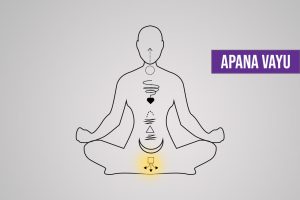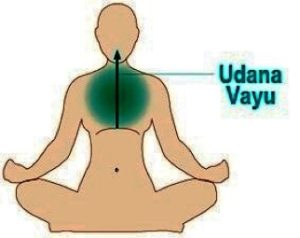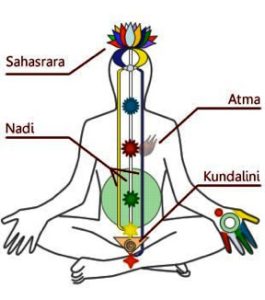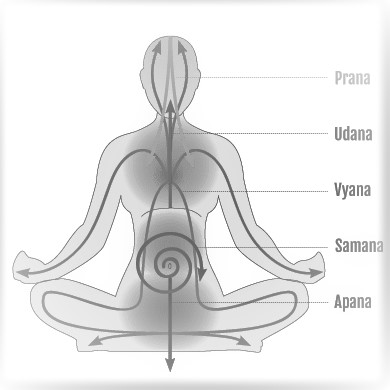
The Five Vital Energies 5 Praans – 5 Airs
The human body’s vital functioning like eating, defecation of waste matter elimination, circulation of blood, sweating, vomiting, tears etc., are all a pneumatic phenomena working under air pressure or gas. Your flow of blood, ejaculation of semen, menstruation, flow of tears, sweating, belching, burping, defecation of waste matter, urinating etc., all physiology functions are achieved by air pressure or gas. The human body vital functions are a pneumatic phenomenon. Vayu, wind, praan are inherited with motion, they flow through all the elements, organs and the mind. There are 5 kind of airs or praans or pancha praan vayu. These five praans are named praan, apaan, vyaan, udaan and samaan. The five praans maintain balance between the physical and mental levels in human a body.

PRAAN VAYU
It is the main of the five praans. It is basically the air we breathe into our lungs. This air is absorbed by capillaries for the vital circulation of blood which is one of the main functions of praan. Praan Vayu is the energy generated not only from the air we breathe but receives energy from the food we eat as well as liquids we drink. Heart, Lungs and mind are maintained by Praan. Essential life giving respiration, breathing, pumping of heart, swallowing and peaceful mind is controlled by Praan. Imbalance in Praan inflow can cause anxiety, fear, depression, anger, breathlessness, asthma, lung related ailments, sleeplessness, heart

stroke, heart palpitations. To keep Praan Vayu in balance you should breathe well with emphasis on inhalation that is inhale and breathe deeply. Meditation generates Praan in the mind. Be in contact with nature, see good visuals, have positive impressions, encourage sensory therapies of colours, sounds, aromas etc for Praan Vayu to provide you the basic energy that drives you in life. Praan Vayu is the first and main of the five praans. Praan Vayu maintains all organs of the thorax including heart and lungs. Praan Vayu is primarily located in the lungs and heart. Praan Vayu is seated in the heart and chest in the Anahat chakra and is governed by the element of air. Praan Vayu moves down and up from the throat centre to the navel centre. Poor intake of oxygen imbalances Praan Vayu. Yoga asaans and Pranayana like Bhastrika (bellows breathe) also Jalandhar Bandh (the throat lock) helps to restore the balance.
APAAN VAYU
It is seated in the abdomen and pelvic floor in the Muladhaar chakra. Apaan vayu is governed by the element earth. Apaan Vayu moves from the navel down to the floor of the pelvis and governs the ability to eject or eliminate what is not needed to the system. Apaan the second of the five praans is primarily responsible for elimination. All organs including kidneys, bladder, colon, rectum, genitals, small and large intestine, kidneys, urinary and reproductive system are controlled by Apaan Vayu.
Defecation, elimination of waste, stools, gas and urine is done by Apaan Vayu. Also ejaculation of serum (sperms), monthly menstrual cycle for women and expulsion of foetus during child birth is done by Apaan Vayu. If you get diarrhea it means the Apaan vayu is too strong. Disturbances, imbalance in Apaan Vayu flow can cause constipation, diarrhea, piles, menstrual problems, sexual issues, bone density issues, skin like psoriasis, eczema, and diabetes. Yoga asaans and pranayama like Kapal Bhatti, (skull shinning brain), purifying forceful exhalation can restore the imbalance in Apaan Vayu. Apaan Vayu controls organs situated between the naval and anus. Apaan Vayu is aligned with force of earth and gravity hence moves downward. Yogic practices can raise Apaan Vayu to unite with Praan Vayu and vice versa. Yoga kriyas can draw Praan Vayu down to unite with Apaan Vayu which occurs in the region of the naval the pranic centre of the body also called Brahma Ganth or sunplexis as seen in the Kundalini.
By such practises Yogis defy age and diseases, achieve a higher place of consciousness.
As Adi Shankaracharya wrote “……to the celibate who conserves the semen with great efforts, what is there unattainable in this word….”
The long process of making semen in human body was revealed by Acharya Sushrat as early as 600 A.D. Energy from food creates blood, flesh, bone marrow which finally forms semen. The 5 days process follows blood – fatty tissue – bone marrow – semen in this process women’s body creates raj and man body creates semen. As per ayurveda one drop of semen is manufactured by 80 drops of blood. Semen pervades the whole body and is thinned by its wastage. There are certain nerves in the body that help preserve semen and this in turn protects the body. In yog shastra it is said falling of semen brings death, preservation of semen gives life. Therefore Brahmacharya should be preserved as much as possible.

In Veds it is mentioned mortals eat food with Apaan Vayu whereas Gods eat food with Praan vayu. Man should control Apaan Vayu, especially the sexual function, for his vital energy not to drain downwards. This may be the reason why Sadhus and Sidh purush’s opt for Brahmachari life. It is said that Swami Vivekanand, like many siddh purush, conserved his serum for higher spiritual growth.
SAMAAN VAYU
It functions between naval and diaphragm thus controlling the working of stomach, liver, intestines etc., Samaan Vayu is seated in the abdominal area in the Manipura chakra and is governed by the element of fire. Samaan Vayu does not travel upwards or downwards but it travels sideways, churning the food in the stomach.
Samaan Vayu does not travel upwards or downwards but it travels sideways, churning the food in the stomach.
Samaan Vayu is the energy that separates nutrients from toxins. Samaan Vayu collects the nutrients and is responsible for digestion of food. It processes, absorbs and assimilates nutrients required for the body and mind. Balanced Samaan Vayu manages ego, mental peace and harmony. Imbalance in Samaan Vayu causes indigestion, stomach disorders, metabolism issues, bloating. Samaan, the equalizer, is disturbed whenever one’s mental peace and harmony is disturbed. The body becomes agitated and causes disorders. Any imbalance can lead to ailments related to poor digestion and assimilation of food, toxic build up, excessive gas, constipation, diarrhea, irritable bowel syndrome, ulcers, anger, aggression, depression, low energy, indecisiveness and dullness. Yogic exercise like kapalbhati, Surya bheda (Sun breath) fasting, uddiyan bandh (the upward flying abdominal lock) can get samaan vayu back on track.
 UDAAN VAYU
UDAAN VAYU
It is seated in the throat and the head area in the Vishudh chakra and is governed by the element ether. Udaan Vayu is the vayu for meditation. It functions above the throat face and head region and is responsible for the sensory organs and so also the functioning of the brain. It also controls movement of hands and legs. Udaan Vayu is responsible for our growth and moves upwards when other four vayus work properly. Our ability to stand, speech and mental functionary are all governed by Udaan Vayu. Udaan Vayu controls speech, production of sound and thought expression. Any imbalance can lead to health issues like tonsillitis, bronchitis, asthma and related throat respiratory problems. Apaan Saaman Vayu Udaan Vayu Asthma, voice hoarseness, depression, poor memory, lack of creativity are all attributed to imbalances in the Udaan Vayu. Udaan Vayu can also affect the nervous health and stubborn weight issues. An irregular Udaan causes breathing troubles, inefficiency in physical and mental work, inability to think clearly or express oneself, uncoordinated speech, weakened will and lack of cheer. Chanting, jalandhar bandh, Ujjay pranayama (the victory breath) and working with all other four vayus can help in healthy functioning of Udaan Vayu.
 VYAAN VAYU –
VYAAN VAYU –
Vyaan means outward moving air hence Vyaan Vayu is available to the whole body. Vyaan Vayu pervades the whole body thus coordinating, balancing, and becoming the integral force that binds everything together. It carries nutrients needed to every cell of the body via blood flow. Vyaan Vayu is like a dynamic reserve store of energy, helping muscular movements. Vyaan Vayu is responsible for distribution of nutrients and energy by moving in a circular pulsating motion.
Vyaan Vayu located in the heart and lungs takes care of cardiac activities, circulation and nervous system. Blocked arteries, heart attack are all attributed to imbalances in Vyaan Vayu. Unbalanced Vyaan Vayu creates lack of coordination, tremors, inability to reach out to people and the mind is erratic. Prayers, rituals, activities that touch our heart, different asnas, benefit vyaana vayu. Air or Praan or Vaayu flow in the body through subtle channels called nadi. Vyana Vayu runs through all the 72000 nadis connecting all the functions of the body including muscle, nerves, veins and joints. yogic breathing like Pranayama Anulom Vilom (alternate nostril breathing) and certain mudras help remove praanic blocks. Vyaan vaayu is seated in the navel and sacral (Swadisthana) chakra and balances water element.
Since breathing process is considered sacred, the eating process can also be made sacred with Praan Agnihotra. Agnihotra is essentially sacrificial offering to the universal fire. When taking food you should chant “Om Praanay Swaha” this morsel of food is for praan vayu “Om Apaanay Swaha” this mortal of food is for Apaan Vayu and so on and so forth for all the five Vayus. “Om Praan Swaha”, “Om Udaan Swaha”, “Om Vyaan Swaha”, “Om Saaman Swaha”, “Om Apaan Swaha” OM is called mukhya praan shakti. This will induce the panch praans, five vayus to be satisfied and give benefits extracted from the food intake. Panch praana vayu are interlinked with our physical energy. Though the actual source of these panch praan is difficult to explain. It is said that source of the panch praan is “Maha Praan”. This Maha Praan is in reality the cosmic energy manifested in all of us as Kundalini shakti.
Udaan Vayu
It is ether, space, in between the throat Vishudh chakra and third eye Ajna chakra in the head thus controlling the sense organs, consciousness. Praan vayu is governed by the element air in the heart and chest Anahat chakra – Samaan vayu is fire in the Manipura chakra in the abdominal region stomach responsible for digestion. Apaan vayu is governed by the element earth in the mooldhara chakra in the pelvic region and governs the reproductive organs, responsible for urination, defecations, and intestines. Emanating from the navel (kanda), Vyaan Vayu pervades the entire body connecting through Swadisthana chakra and is governed by its element ‘water’.
Udaan Praan
It is the ascending energy that flows from the heart to the head and brain. Udaan Praan accompanies the awakening of the Kundalini Shakti. It is with the assistance of Udaan Praan that the Astral body separates itself from the physical body. A strong Udaan Praan eases the phase of death. With the control of Udaan Praan, the body becomes very light and one may gain the ability to levitate. When Udaan Praan is in our control, external obstacles such as water, earth or stones no longer obstruct us. Intense practice of the Yoga breath exercises also gives the possibility of walking on water, or even floating in the air.
Fakirs who sit or lie on a bed of nails possess the ability to control their Udaan Praan. Yogis who live in the forest and remain unaffected by heat, cold, thorns and insects, etc., are protected through the control of Udaan Praan. Other than the panch praan vayu these are five Upa praans which include Burping, Blinking, Yawning, Sneezing, Opening and closing of heart valves. As per Vedic texts there are 49 maruts, airs, praans, vaayus, regulating our body of which 5 are vital and 5 are subsidiary the earliest reference of the concept of praan mentioned in Veds and upnishads can be found in 3000 year old Chandogya Upnishad. As per Devi kavach Maa Vajra Hasta is the Devi for the five airs, panch praan vayu. Devi Kavach also mentions that Maa Kuleshwari protects our abdomen, similarly Maa Shool Darni stomach, Kanini Navel, Gulyeshwari secret parts, Pootna and Kamika Penis, Mahish Vahini Anus, and Brahmini Semen.
 Praan is distributed throughout the whole body, through the network of the Nadis (nerves). There are 72,000 Nadis in the human body. Of these, there are three Nadis of particular importance. The three principal nadis are Ida, Pingala and Sushumna. Ida meaning ‘comfort’ in Sanskrit lies to the left of the spine. Ida is associated with lunar energy corresponding to the left hand side of the body and the right hand side of the brain. It extends from the left testicle to the left nostril. It corresponds to the Ganga River. Pingala is associated with solar energy. It is tawny light yellowish brown colour and is to the right side of the spine in a mirror image to Ida. Pingala solar nadi corresponds to the right hand side of the body and the left side of the brain. It extends from the right testicle to the right nostril. It corresponds to the river Jamuna.
Praan is distributed throughout the whole body, through the network of the Nadis (nerves). There are 72,000 Nadis in the human body. Of these, there are three Nadis of particular importance. The three principal nadis are Ida, Pingala and Sushumna. Ida meaning ‘comfort’ in Sanskrit lies to the left of the spine. Ida is associated with lunar energy corresponding to the left hand side of the body and the right hand side of the brain. It extends from the left testicle to the left nostril. It corresponds to the Ganga River. Pingala is associated with solar energy. It is tawny light yellowish brown colour and is to the right side of the spine in a mirror image to Ida. Pingala solar nadi corresponds to the right hand side of the body and the left side of the brain. It extends from the right testicle to the right nostril. It corresponds to the river Jamuna.
Sushumna interpreted as ‘very gracious’, ‘kind’, runs along the spinal cord in the centre piercing through the seven chakras. Sushumna connects the base chakra to the crown chakra.
vayu mool mantra :-
‘om pm pm om vaam vaam om yum yum om pawanpurushaay namh’ itti moolmantra!

Please Forgive me for any short comings or mistakes in the above 2 texts part 1 and part 2 which I have either gained, or heard from scholars saints or researched to the best of my knowledge and credibility.








